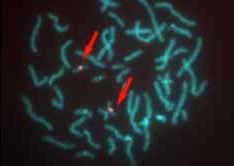Investigators from the University of Ferrara, Italy have found evidence suggesting that high levels of iciHHV-6 U94 may predispose to the formation of marker chromosomes. A patient with diffuse large B-cell lymphoma (DLBCL) was negative for both EBV and HHV-8 but positive for inherited chromosomally integrated HHV-6A (iciHHV-6A) in the 17p chromosome. They also found integrated HHV-6 in a marker chromosome, an abnormal piece of a chromosome that is seen in some cases of leukemia and other cancers such as DLBCL.

Daria Bortolotti, Dario Di Luca, and Roberta Rizzo of University of Ferrara.
Since HHV-6 U94 was the only gene expressed, and because it was expressed at a high level due to inherited chromosomal integration, the group theorized that U94 may have been behind the development of the marker. U94 is a protein with DNA-binding, exonucelase, and helicase-ATP activities, all properties that raise the possibility that the integration could help explain this abnormality in the biology of DLBCL.
Inherited chromosomally integrated HHV-6 occurs in approximately 0.8% of controls and approximately 2% of patients (Pellett 2012). Currently, iciHHV-6 is associated with an increased risk of angina (Gravel 2015), and it may cause an increased risk of aGVHD and CMV disease in transplant patients (Hill 2017).
Recurrent chromosomal aberrations or marker chromosomes have been commonly found in DLBCL patients and represent an increased risk of malignant transformation, but little is known about their origin. The investigators propose that this finding may represent a clue.
For the full paper, see Campioni 2017.

